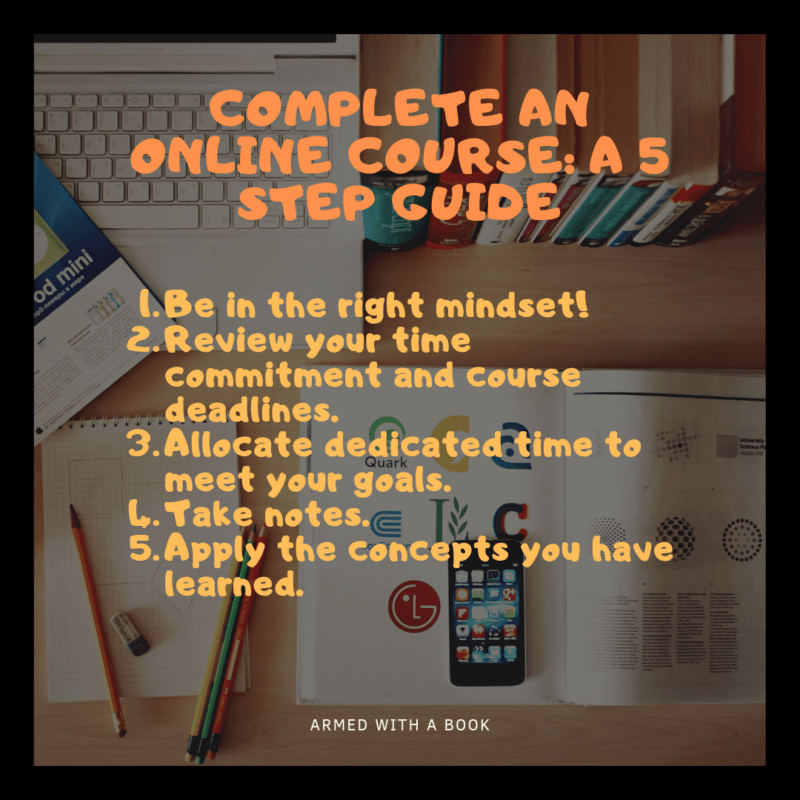
I love learning online for a variety of reasons. Whether it is to learn something new or update my prior knowledge, online courses through platforms like edx.org and coursera.org offer a wide variety in a number of subjects areas. Recently, they have also started offering certificates, specializations and degrees so that anyone can upgrade their credentials from anywhere! Today, I want to share 5 steps you can take to complete an online course successfully. These are methods I have tried and are a part of my own routine, anytime I pursue education online.
Let’s say you have found a course online that you are interested in and want to complete in the coming weeks. Here are some points to keep in mind to set you up for success:
Before You Start
# 1 Be in the right mindset!
Answering the Why
Nowadays, it takes only a click to get access to material that you are interested in. But with so much information available at our fingertips to consume, it can be hard to decide which one to pursue! This is a dilemma I encounter often when I am inspecting websites for things to learn about so I ask myself one question before I commit to a course:
Why do I want to take this course?
For example, through work, I am currently pursuing a Data Mining Specialization on coursera. The first course in the specialization is about data visualization. Here are my reasons for taking it:
Though I have worked at visualizing data for many years now, I have never learned about it in theory and thorough other examples – non-work related. I loved Data Mining during my B.Sc. and this course is the perfect opportunity to reconnect with those tools through visualization, something I use everyday. Now, as a data analyst, I will have a better chance to apply the skills I learn here.
This question is very important, not just because the answer clearly states why something is relevant at this point in time, but also because it should be the driver to justify the course if you have to pay for it. If you are hoping to get any certification online, it will not be free, like Honor certificates used to be in the early days of online learning.
Face your doubts
Once you have made a monetary commitment to the course, or decided to, some fears might cross your mind. What if I don’t understand the material? What if I suck at the assignments? What if my peers in the course do not like my work? (Many courses have assignments that are reviewed by peers and that can be daunting if you have never done that before.) What if…?
Confront your feelings of inadequacy and fear of failure.
This is true for any kind of learning that you pursue, whether online or offline. To complete any course successfully, know that it is always in your hands. If you don’t understand something, you will work hard to get it. It’s not about what your peers think. It’s about the effort you are willing to put into the course.
If you have never been graded by peers before, know that others also share the same fears. Assignment marking guidelines are very thorough in all online courses I have taken and peers grade each other on a predetermined rubric. This same rubric will be available to you when you start working on your assignment. So don’t worry. Your fears are only telling you to dig deeper into your commitment and that is a good thing.
# 2 Review your time commitment and course deadlines.
Online courses can be self-paced where the course is open for a long span of time, or have a fixed start and end date, usually ranging from a month or two months. On coursera, for example, if you start an online course and do not finish it before it closes, you can transfer your work to a new course section, which has new deadlines. This is to make learning flexible for you, the learner, because things come up and sometimes, we cannot wrap up what we started. I always plan to keep this at minimum because even if there is the option to extend the course into another month, that means paying for access to it for more time.
To avoid this, I set deadlines:
- If the course I am taking is self-paced, I will set my own deadlines.
- If the course has predetermined deadlines for the assignments (these courses usually have peer-graded assessments), I will set my personal deadlines to be a couple days before the actual deadline. This way, I will have a buffer in case I do not end up completing things in time. This could be because something came up, or the assignment took longer than I had anticipated, or simply because the material required more time to understand.
All courses I have encountered so far, on edx and coursera, give an estimate for how much time each reading and assignment will take to complete. Take these times into consideration, along with your commitments, and plan accordingly.
I always keep a list of the deadlines and tasks that I must complete each week by my desk so that they are always in my field of vision as I work. I check out the material that I complete over time and the sense of accomplishment stays with me. This also makes sure that I don’t forget about the course I enthusiastically joined couple weeks back, because we all know that happens!
While you are Learning
# 3 Allocate dedicated time to meet your goals.
You could use one of the following things to figure out how much time you should dedicate per week to complete the course.
- how many hours you need every week on average – you can find this information on the sign up page for the course.
- how many hours it would take to complete a given week – this is based on the time needed to complete all the materials and assignments. Some platforms outline this clearly, while others might require you to estimate using time for video lectures, assignment requirements, time to prepare for quizzes, multiple attempts, etc.
- how thoroughly you want to engage with the course (see # 4).
I devote one or two of my evenings to the coursework I am pursuing. At least one day on the weekend might go towards the course as well.

# 4 Take notes.
There is ample research out there that shows that one remembers more by taking notes by hand rather than typing them. This is because when we write, we tend to paraphrase rather than copy word-to-word. According to Effectiviology, note-taking by hand is more beneficial for conceptual learning, as compared to for factual learning.
The advantages of taking notes by hand are more significant in the case of conceptual learning, since it requires a deeper processing of the material compared to factual learning, which only necessitates a shallow interaction with the material.
Effectiviology
I have tried both techniques – taking notes by hand or on the computer while learning online. You might think that it would be easier and faster to take notes by typing because then you are just concentrating on one screen. Also, most online learning websites are equipped to let you take snapshots of the lecture slides, add comments to the material and highlight.
The truth is, it depends. I took a course on Social Media interactions on edx and that was factual in nature, talking about the different types of blog posts that one can write and the advantages of different platforms. No one would ever test me on these things and I wanted to go back to them in the future. Hence, I typed by notes.
On the other hand, for my current course on data visualization, I have opted to handwrite notes. I don’t ever expect to need any of the material word-to-word. Also, I enjoy color coding the lecture notes, my thoughts around them and any insights I might have gained in connection to my work. I also make flowcharts which are not possible to add to my course notes.
There is no right way of taking notes. Ultimately, do what suites your needs but do take notes and remember, notes are also helpful during the quizzes! 🙂
What else?
It’s not enough to take notes and expect to learn everything. To truly make the material your own, you have to spend sometime reflecting on it. Here are some ideas:
- Explain a concept you have learned to someone else. You could make a video about it, or a short blog post, anything!
- Research deeper into the subject and look for other ways of doing what you are learning. Remember that courses are still limited in what they teach you. To deepen your understanding, find other alternatives.
- Create infographics to summarize what you are learning.
- Keep a log of questions that you want answers to later.
- Note down an area that was mentioned in the lectures which you do not know anything about and look into it more.
- Play around with the software that the course uses (if any).
There are so many things you can do to make what you have learned more on concrete!
After it’s all done

# 5 Apply the concepts you have learned.
The ideas in # 4 are a great way to be connected with and build on the things that you have learned. If you like blogging, continue to share your learning journey, even if you feel that many others have already written about the topic. Like I said earlier, it is all about the effort you are willing to put into learning and growing.
Other things you can try out:
- Take a related course about the topic which builds on what you have learned.
- Read some books or articles about it.
- Join an online discussion about the topic.
- Collaborate with your peers.
Learning does not stop once you have completed the course. Your journey has only begun!

But don’t forget to celebrate: Congratulations! You made it! 🙂
I hope you enjoyed this 5-step guide to complete an online course successfully! If you are not sure what you want to learn about, check out my article on building an action plan:
Happy Learning!
Feature image: Photo by salvatore ventura on Unsplash
Photo of pencil shavings from visualhunt
Photo of colored pencils: by Agence Olloweb on Unsplash

Be First to Comment